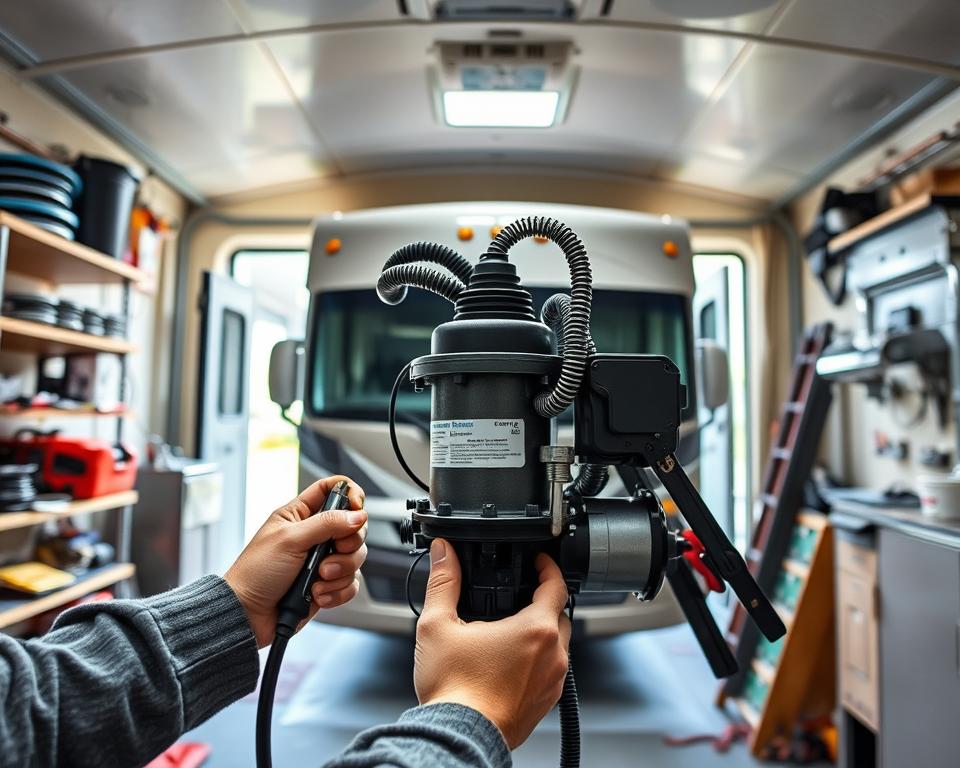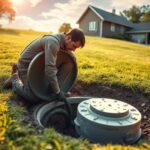Motorhome Tank Pumping Overview: Maintain Optimal Performance
Have you ever been intrigued by what happens if you ignore your motorhome’s tank pumping needs? Poor waste management can significantly impact your comfort and safety while traveling. Unpleasant smells and costly fixes are just the start. Adequate sanitation system upkeep is imperative for any RV owner. Regular RV tank pumping and thoughtful practices can avoid catastrophes during your trips. This RV septic pumping guide will detail the value of effective waste removal and how to care for your RV’s system perfectly.
Getting to Know Your RV Waste Setup
Motorhomes include a custom waste system for proper waste management while on the road. It consists of black tanks for sewage and gray tanks for sink and shower wastewater. Familiarity with tank functions is essential for maintaining them properly.
Monitoring your RV’s waste system is essential to avoid clogs and backups. These disruptions can wreck your travels and create unhygienic conditions. Regularly checking black and gray tank levels helps ensure optimal operation. This is crucial for hygiene and protecting a healthy environment.
Proper waste disposal is key to your comfort and environmental responsibility. Using your RV’s waste system correctly ensures waste is managed and disposed of effectively. Understanding the plumbing and disposal methods in your RV is important for seamless travel experiences.
The Value of Timely RV Tank Emptying
Regular pumping of your RV’s tank is key to a smooth-functioning waste system. Over time, solids build up, leading to unpleasant odors and possible blockages. Such issues interrupt your travels. On-schedule tank pumping avoids these problems and saves you from expensive repairs due to neglect. It’s vital for managing wastewater efficiently, ensuring safe disposal.
Timely pumping wards off odors and extends the plumbing’s life. By maintaining a regular pumping routine, RVers keep their vehicles in top shape. This prevents odors and travel headaches, underlining the value of regular maintenance.
| Advantages of Consistent Tank Emptying | Consequences of Neglect |
|---|---|
| Reduces odors | Increased unpleasant smells |
| Prevents clogs | Pump failures |
| Enhances system longevity | Costly repairs |
| Encourages eco-friendly disposal | Environmental hazards |
Knowing why to pump regularly optimizes your system. It ensures stress-free journeys, letting you concentrate on exploring instead of waste management.
How Often Should You Pump Your RV Septic Tank?
How often to empty your septic tank matters for system health. Generally, the recommendation is every three to five days when in use. This interval may change depending on factors like tank size and number of occupants.
If your RV has a smaller tank or more people onboard, you might need to pump more often. Watching your black tank’s levels is crucial for upkeep. Aim to pump when it’s about two-thirds full. This approach simplifies waste removal and helps avoid troublesome situations.
Regular black tank care prevents blockages and smells. Knowing capacity and monitoring fill level helps set the optimal schedule, tailored to your circumstances.
| Consideration | Suggested Interval |
|---|---|
| Light usage | Every 3–5 days |
| Heavy usage | Every 2–4 days |
| Limited capacity | As needed (often every 2 days) |
| Level-based pumping | At two-thirds capacity |
Optimal RV Tank Emptying Methods
A structured routine ensures clean tank dumping. Always start by emptying the black tank to ensure efficiency. This method reduces odors and guards against mixing with gray water.
Choosing a sturdy sewer hose designed for this task is crucial. It provides strength and maneuverability, key for a clean process. Ensure all connections are tight to prevent leaks. After emptying, rinse the tank well with water to remove residual waste and maintain cleanliness.
Do not keep the black tank valve open when hooked up at a full site. A closed valve allows solids to dissolve fully, avoiding blockages. Adhering to these practices ensures cleaner tanks and fewer foul odors.
| Key Steps | Description |
|---|---|
| Start with Black Tank | Black then gray for best flushing |
| Invest in Gear | Choose a durable sewer hose for efficient dumping |
| Flush Thoroughly | Thorough rinsing prevents buildup |
| Avoid Leaving Valve Open | Keep black tank valve closed when hooked up to prevent solids buildup |
Preventing Odors and Clogs
To ensure your RV remains fresh, effective waste management is key. RV tank odors can spoil your trip fun. Using water correctly helps break down waste, avoiding clogs. Choosing RV-safe toilet paper is wise as it breaks down easier, reducing blockage risk.
Enzyme-based treatments can dramatically improve sanitation. Unobstructed vents is crucial for odor control and proper airflow. Frequent flushing after each use ensures tanks stay clean, avoiding aroma issues.
Correct disposal practices are vital for clog prevention, focusing on human waste and RV-approved items. Following these recommendations lets travelers maintain a hygienic environment for enjoyable journeys.
When to Call in a Pro
Recognizing when to book a pro saves headaches. Act quickly if you notice slow drainage, lingering odors, or stubborn clogs. These signs indicate the system may need more than routine care.
Choosing a trusted service like All in Sanitation ensures a deep clean. Their technicians have specialized tools for clearing clogs and sanitizing tanks after emptying. This maintenance not only ensures cleanliness but also extends your system’s lifespan.
Watch for these indicators before you call a pro:
- Water backs up slowly
- Persistent odors after emptying
- Visible waste remnants post-pump
While regular upkeep is crucial, sometimes professional help is necessary. Timely expert intervention turns major headaches into manageable tasks.
Sustained RV Waste System Upkeep
Long-term RV care goes beyond frequent pumping. A thorough strategy is key to lasting performance and efficiency. Begin with regular deep-cleaning of tanks to prevent harmful buildup and future complications.
Regular inspection of dump valve seals prevents leaks and odors. Damaged seals can spoil your adventures. Catch problems early with routine checks to prevent costly repairs.
Functional sensors ensure proper fill-level data. Faulty sensors can give incorrect tank levels, risking overflows or unnecessary pump-outs. Inspect these components routinely to maintain system accuracy.
The following table outlines key long-term maintenance tasks and suggested intervals:
| Maintenance Task | Interval |
|---|---|
| Thorough Tank Cleaning | Biannually |
| Inspect Dump Valve Seals | Each journey |
| Sensor Function Test | Every month |
| Sanitize System | Annually |
Adhering to this plan saves time and money. Meticulous care ensures worry-free adventures without septic troubles.
Benefits of On-Site RV Waste Removal
On-location pumping offers ultimate convenience. It’s a boon for remote camping without dump stations. These services prioritize ease, ensuring sanitation without extra travel.
Professional RV waste removal is efficient and eco-friendly. It assures proper disposal, saving time and keeping campsites clean and comfortable.
Understanding these benefits enhances trip planning. These services support sustainable camping by promoting responsible waste management. They blend ease with environmental responsibility.
Conclusion
Regular care of your RV’s tanks is critical for system longevity and efficiency. Timely pumping and understanding your waste setup are essential. These steps form the basis for a positive experience. A well-kept RV prevents odors and costly repairs.
Being proactive about waste management lets you focus on adventures. Regular upkeep or professional help ensures your comfort is maximized, making your trips effortless and memorable.
Proper timing and techniques keep your system running smoothly. With this knowledge, embark on new adventures confidently, knowing your RV is prepared for any experience.



